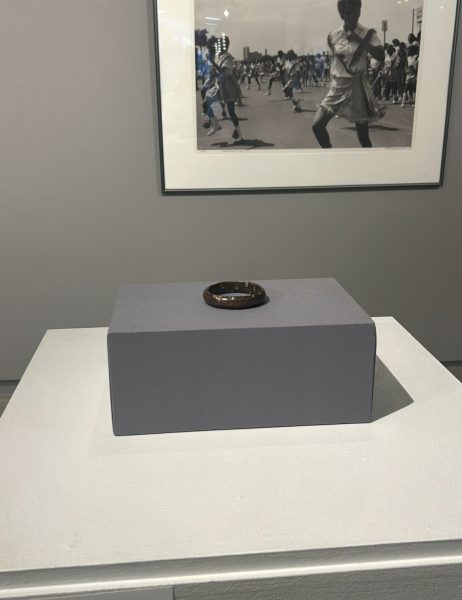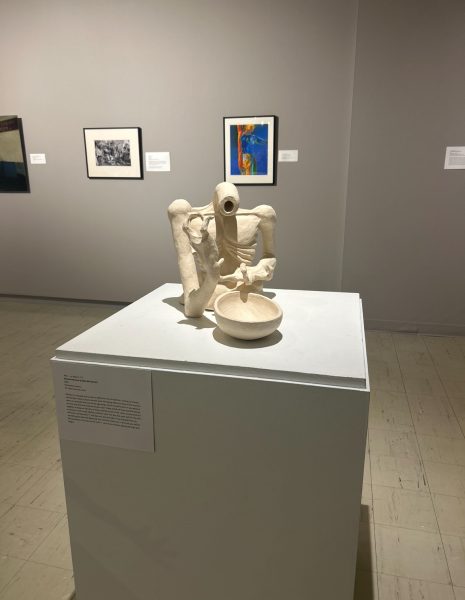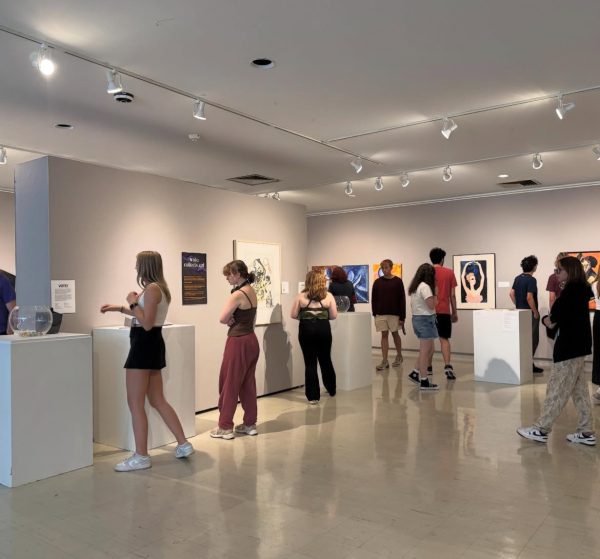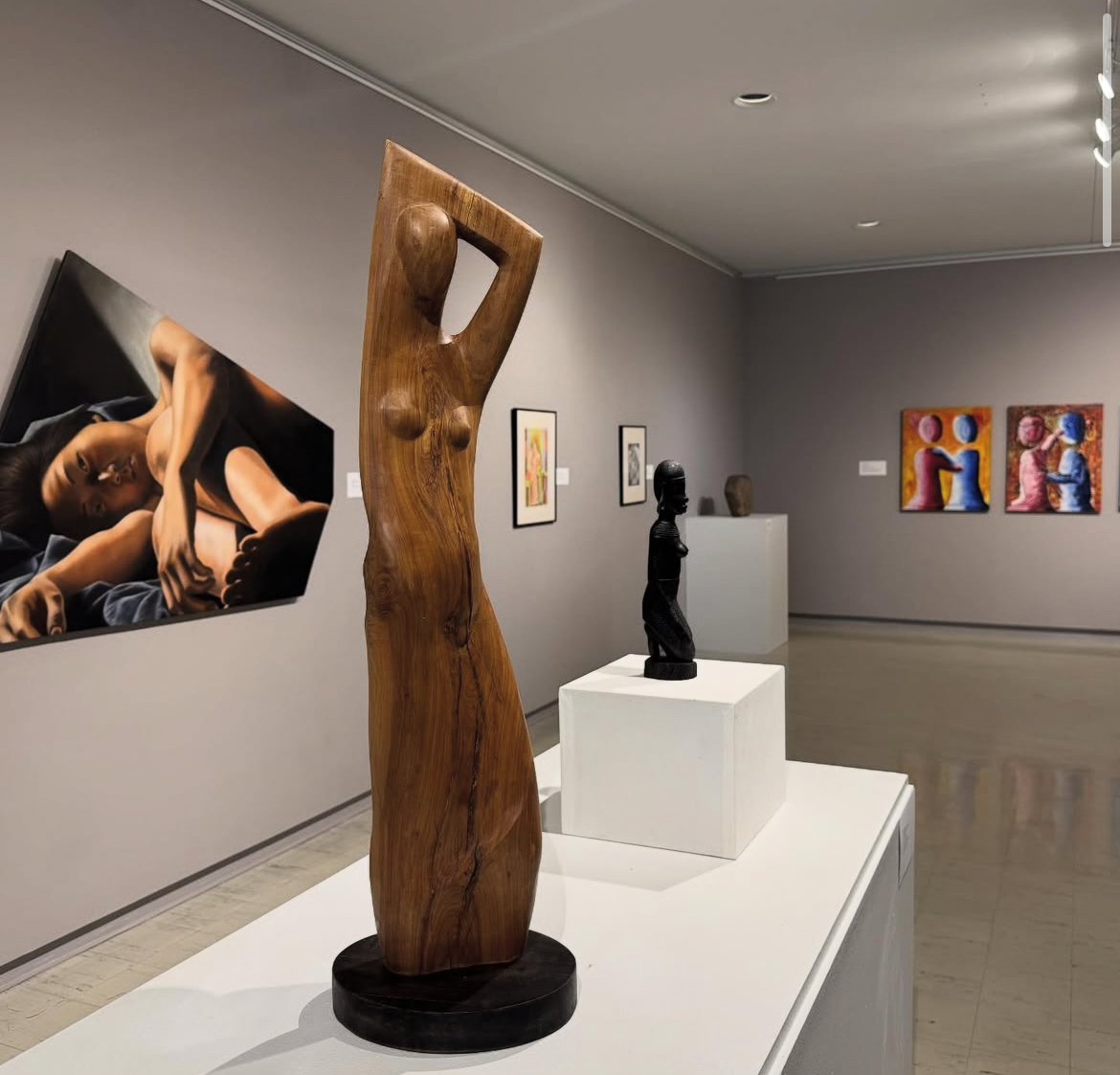What is a body and what can it represent? No doubt it’s fat, flesh and skin that cover a skeletal structure. Then set into motion by muscles and made to feel by firing synapses and sensory perceptions. But this is only the beginning. Throughout history, the diversity of bodies in scale, form and color have offered inspiration for artists. The human form is used in seemingly infinite ways to express and explore human experiences.
The Bodies: Humans in Art exhibition held at the Crossmen Art Gallery Sept. 8 to Oct. 2 highlights four of these possible themes: Understanding the Human Form, Gesture & Movement, The Body & Politics, and Corporeal Identities.
“Every academic year, I like to start out with a showcase of things from the collection,” Crossman Gallery Director Ashley Dimmig said. “We have over 2,000 pieces and it’s just a matter of playing with them and figuring out which ones work cohesively together.”
In the gallery, art pieces range from textiles to oil paint and from local to historical to even student work.

“As a current undergraduate student I have found it hard to wrap my head around that possibility,” senior artist Hannah Memmel said. “Having a showing of professional artists, former graduates, and current students makes professional gallery showings feel more attainable and less like a far of fantasy like maybe being an A-list famous Hollywood actor would be. It lessens the intimidation that one might feel going down the path of being a professional artist.”
Two student art pieces are showcased in the exhibit. “Seeing is Believing” is a copper bangle that stems from the artist’s experience of not being believed when you say you are visually impaired. The piece features braille on the outer side that says a question asked by almost anyone curious about someone’s vision.
“My piece encourages the viewer to physically touch and interact with my art, in other words, using their body to learn about an experience they wouldn’t often consider,” junior artist Emma Bjurquist said. People ask me about the piece all the time and then ask me if I’ll tell them what the braille says and I always say no because I want them to do the work of figuring it out, if I tell you, that ruins the point of the work.”
Aside from the mental aspects, the piece, like any other in the art gallery, can take on many meanings.

“My experience is also deeply interrelated with my own body since I rely on my hands to experience different aspects of the world rather than through my eyes,” Bjurquist said.
The second one, “Who… or What is ‘I,’” is a stoneware ceramic meant to cover the undefinable concept of identity.
“My work connects in the most basic way, as it is a depiction of the human body, though it is distorted and deformed,” Memmel said. “It is a physical representation of an interior struggle. This piece translates something that can be a struggle to put into words and gives it form to make it visible so you can point to it and say ‘That. That is what it feels like.’”
While both of these art pieces were placed into Corporeal Identity, the gallery covers many different perspectives and messages.
“For me personally, my area of expertise is Islamic art, and there’s always questions about, should people or figures be represented in art, or should it not? And so it’s always kind of a question, and I think people just assume most art has people in it, and that’s not always the case. And so to look at and really consistently unpack what place the human body has in art and how many different ways it can show up,” Dimmig said. “We’re talking about studying positions, but also about aging or gender issues. Some even touch on dying in war or bodies used in harsh labor practices.”
Both artists agree that sometimes art is just for fun and messages get blurred throughout the process.
“I am an art education major and an opinion I will consistently fight for is that art does not have to have a deeper meaning or any meaning at all. Even if you are making something random like a little doodle of a goose on the side of your notes, you are still making artistic choices, they might be more simple rather than complex but you always make choices in art,” Bjurquist said.
Even so, a gallery provides the ongoers to appreciate the work and find perhaps sometimes vital accidental allegories within the piece.

“Without room to engage with a piece through the process of crafting one’s own meaning, a piece of art quickly becomes just another object,” Memmel said. “Leaving room for interpretation and giving space for others to craft their own ideas of what the meaning of a piece is how a work lives on. If a work gets people to think, talk, argue, and theorize then it is successful. The viewer is the one who holds the power in the end to determine if a piece is remembered or lost to time.”
If you are interested in fleshing out your own meanings and starting a conversation, visit the Crossman Gallery website.


